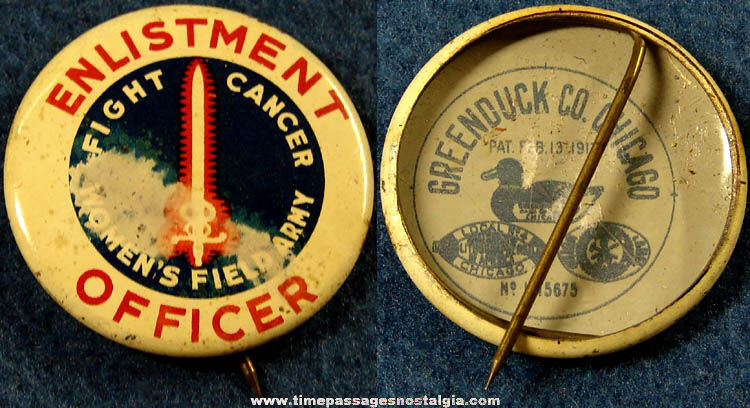
   | | Any group of items being offered as a lot must be sold as a lot. | | | Great memories
make great gifts! | All Original Items.
No Reproductions | | Fast Dependable Service | Nostalgic Memorabilia, Pop Culture Artifacts, Historic Items,
and "Shoe Box Toys" | Quantity Discount Prices
(when available) | | We have an extensive inventory that is not yet on our web site. If there is something you are looking for and did not find, please send us your wish list. | | Quality Merchandise At Reasonable Prices | It's never too late to
have a happy childhood! |
| | | | The picture shows a front and back view of this 1930s American Society for the Control of Cancer Women's Field Army Enlistment Officer Pin Back Button. This is a tin pinback button that is imprinted in red and blue on a white background. It pictures a sword on the front. The back has the manufacturers duck logo and two union markings. It is marked on the two sides as follows: FIGHT CANCER
WOMEN'S FIELD ARMY
ENLISTMENT OFFICER GREENDUCK CO.
CHICAGO
PAT. FEB.13,1917
NO.1215675 This pin back button measures 1-3/8'' wide. It appears to be in good condition with a white spot across the front as pictured. Below here, for reference, is some additional Historic information: The Women's Field Army ''In 1936, Marjorie G. Illig, an American Society for the Control of Cancer (ASCC) field representative and chair of the General Federation of Women's Clubs Committee on Public Health, made an extraordinary suggestion. She proposed creating a legion of volunteers whose sole purpose was to wage war on cancer. The Women's Field Army, as this organization came to be called, was an enormous success. Its recruits donned khaki uniforms, complete with insignia of rank and achievement, and went out into the streets to raise money and educate the public. In 1935, there were 15,000 people active in cancer control throughout the United States. At the close of 1938, there were 10 times that number. More than anything else, it was the WomenÕs Field Army that moved the American Cancer Society to the forefront of voluntary health organizations.'' |
|
Click on image to zoom.
 |